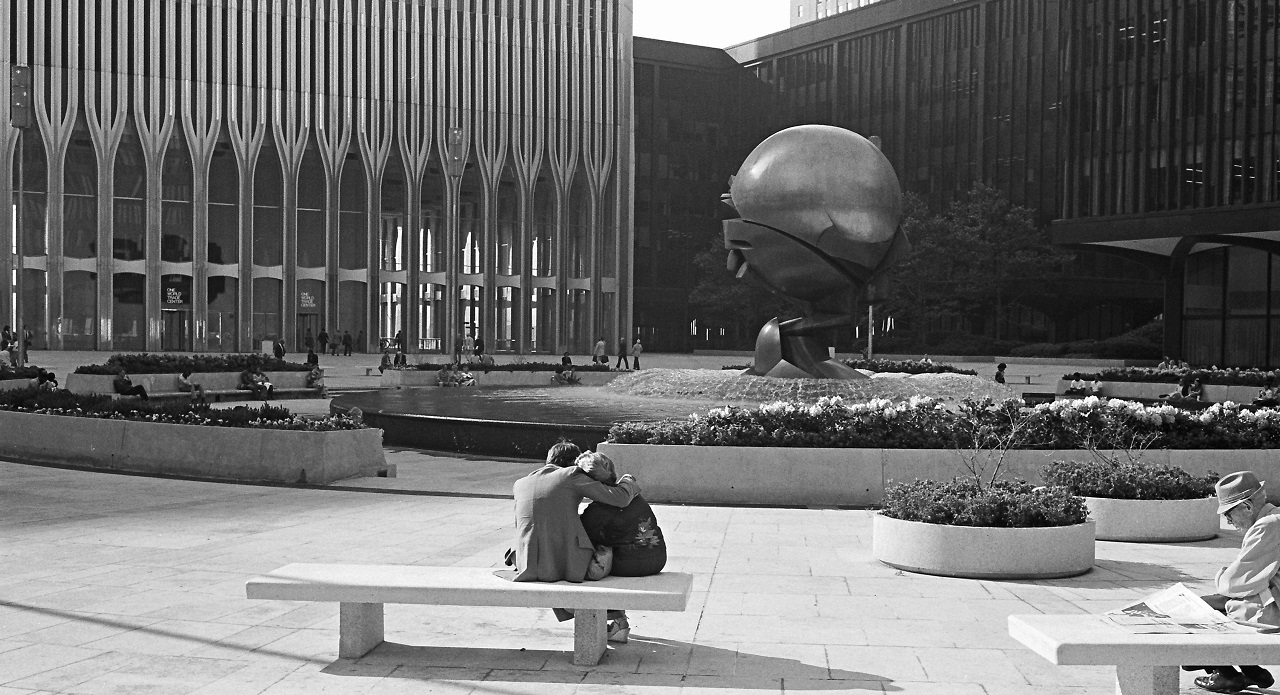Make a donation to the museum
Art and Artists at the World Trade Center
The World Trade Center was a place that celebrated the international community through art as well as business. Iconic sculptural installations dominated the Plaza, and artists from around the globe had studios at the Twin Towers. The 9/11 attacks damaged and destroyed hundreds of pieces of irreplaceable art and nearly one million unique historical artifacts housed at the World Trade Center complex. As a result, an important part of the world’s shared cultural and artistic heritage was lost forever.
alt
A Metropolitan Oasis
From the outset, Japanese American architect Minoru Yamasaki envisioned art as a key part of the commission to build the World Trade Center. Recognizing that the 110-story Twin Towers might appear “gloomy and fearsome” from below, Yamasaki’s 1966 design called for a public plaza at ground level to help make the space more “friendly” and “inviting.” With a large fountain as the focal point, and flower beds and pieces of contemporary sculpture arrayed across the vast space—officially called the Austin J. Tobin Plaza—the architect hoped that tourists, downtown workers, and occupants of the new World Trade Center would consider the Plaza an oasis in the middle of lower Manhattan.
Visitors and people who work in the Trade Center will find this grand five-acre plaza a mecca, a great relief from the experience of the narrow streets and sidewalks of the surrounding Wall Street are. —Minoru Yamasaki
In 1969, the Port Authority instituted a Percent for Art program, setting aside up to one percent of total project construction costs to acquire art for the 16-acre site. From the early 1970s to 1995, the Port Authority installed seven specially commissioned, one-of-a-kind works of public art at the World Trade Center. Some of them—such as German sculptor Fritz Koenig’s 25-foot bronze The Sphere and American artist James Rosati’s 23-foot Ideogram—became emblematic of the World Trade Center, appearing in countless tourists’ snapshots and professional photoshoots alike.
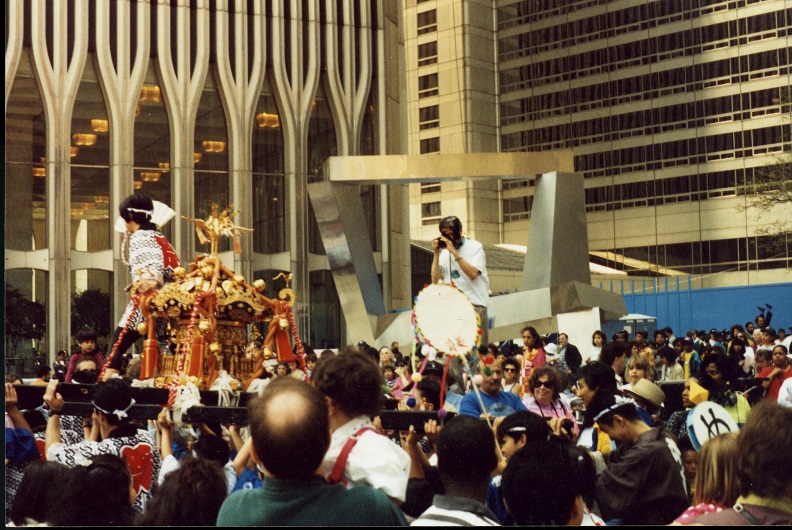
Children's Day at the World Trade Center on the Plaza with James Rosati’s Ideogram in the background, undated. Collection 9/11 Memorial Museum.
Views From Above
While tourists snapped photographs of the sculptures on the Austin J. Tobin Plaza, painters, sculptors, photographers, and other creative artists from across the United States, as well as Australia, Iran, Israel, Jamaica, Korea, Norway, the United Kingdom, and other countries, were invited to set up temporary studios at the World Trade Center.
From 1997 to 2001, the Lower Manhattan Cultural Council (LMCC), in partnership with the Port Authority of New York and New Jersey as well as other corporations and foundations, sponsored two residency programs: World Views and Studioscape. These programs provided artists with free studio space in the North Tower. During the course of their residencies, artists enjoyed 24-hour access to unrented office space on the 91st and 92nd floors, as well as on several other floors. The extraordinary setting inspired many participants to create pieces that reflected their unique view from above. Norwegian-born Torild Stray, who joined the first cohort of World Views artists in 1997, remembered experiencing vertigo when she first saw the city from the windows of her studio in the North Tower. Like other artists-in-residence, however, Stray came to find that the bird’s eye view gave her a novel perspective. “The cityscape became a part of my vocabulary in a whole new way,” she remembered in 2017.
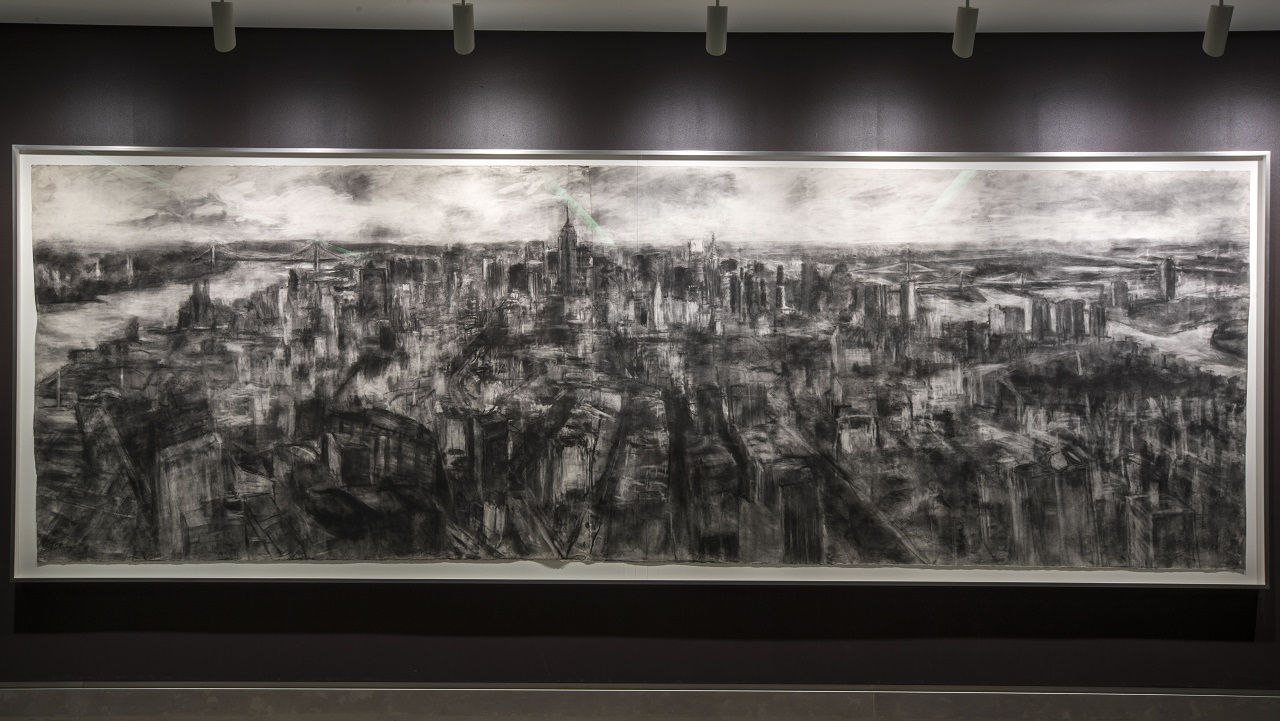
New York Metamorphosis (1998), an expansive charcoal drawing by Torild Stray, depicts a panoramic scene of New York City at dusk, looking north from the World Views studio space on the 85th floor of the World Trade Center’s North Tower. Collection 9/11 Memorial Museum, Gift of Petter Neslein, Pecunia AS.
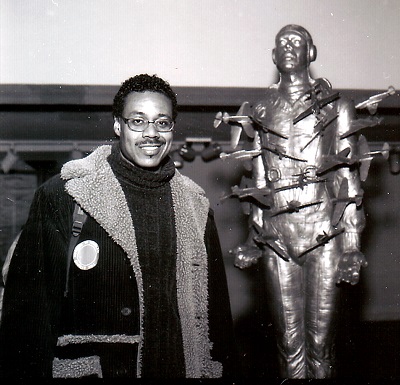
Sculptor Michael Richards with his work, Tar Baby vs. St. Sebastian, 1999. Courtesy of Frank Stewart.
One World Views artist-in-residence, Brooklyn-born sculptor Michael Richards, was killed as a result of the 9/11 attacks. On the morning of September 11, 2001, Richards was in his 92nd-floor studio when hijacked Flight 11 crashed into the North Tower. When the tower collapsed 102 minutes later, Richards’s artwork, along with most of his fellow artists’ works in progress, was destroyed. Richards perished in the attack.
Damaged, Destroyed, and Recovered Art
After the attacks, insurers estimated that the art destroyed on 9/11 was worth at least $100 million. Of the seven monumental artworks that the Port Authority had commissioned, only Koenig’s iconic The Sphere was recovered from Ground Zero, damaged but mostly intact. Private art collections housed in company offices in the World Trade Center were also lost when the Twin Towers collapsed. Cantor Fitzgerald, a financial services firm that occupied the 101st to 105th floors of the North Tower, had such extensive art holdings that the press called their offices “a museum in the sky.”
Significant historical artifacts from archaeological collections stored in the basement of 6 World Trade Center were also destroyed in the attacks. Thousands of these artifacts came from an excavation of the African Burial Ground in lower Manhattan, where an unknown number of enslaved and free Africans were interred in the 17th and 18th centuries; nearly one million came from an excavation of the Five Points neighborhood, a 19th-century immigrant community. While some boxes of artifacts from the African Burial Ground were recovered from Ground Zero, all but a handful of the artifacts found at the Five Points site were destroyed.
Because many companies and organizations had kept their inventories as well as their collections at the World Trade Center, a full tally and appraisal of the lost art and artifacts within the complex will likely never be known.
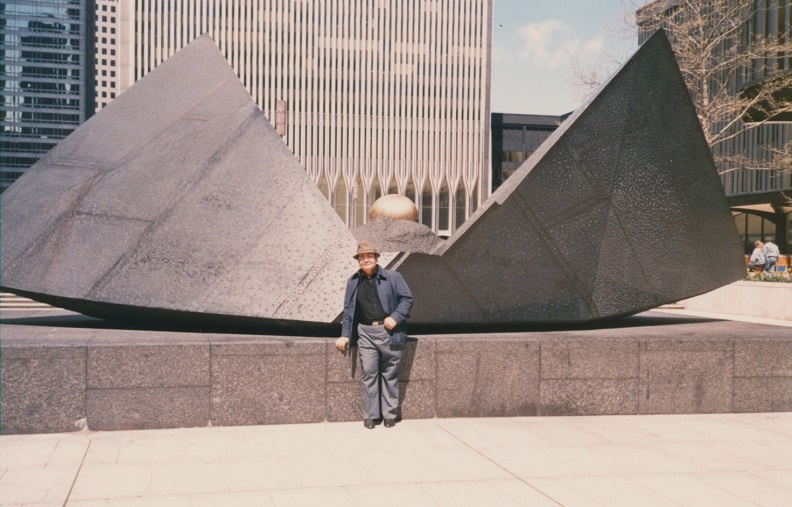
Hernando Rafael Salas in front of Japanese sculptor Masayuki Nagare’s Cloud Fortress on the Austin J. Tobin Plaza, undated. Salas perished in the 9/11 attacks. Collection 9/11 Memorial Museum. Gift of Nelcy Salas de Campana in memory of her father, Hernando Rafael Salas.
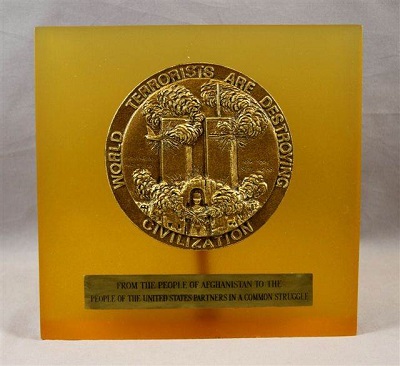
Plaque presented to the people of the United States from the people of Afghanistan, January 28, 2002. Courtesy of the George W. Bush Presidential Library and Museum.
Global Connections
The art at the World Trade Center had symbolic as well as monetary value, and al-Qaeda’s attacks on September 11, 2001, destroyed irreplaceable expressions of American and international culture. The art lost in the 9/11 attacks serves as a reminder of the threat that violence and terrorism pose to humanity’s shared cultural heritage.
From ancient times to the present day, military and political factions have attempted to assert the dominance of their ideologies by destroying the art and culture valued by their enemies or predecessors. In March 2001, six months before the 9/11 attacks, the Taliban used dynamite, artillery, and rocket launchers to obliterate Afghanistan’s colossal Bamiyan Buddhas, 1,500-year-old Buddha sculptures carved into cliffs in the Bamiyan Valley.
In January 2002, Hamid Karzai—Chairman of the Interim Administration of Afghanistan and future president of Afghanistan—presented U.S. President George W. Bush with a plaque depicting one of the Bamiyan Buddhas, wreathed in smoke, in front of the burning Twin Towers. Engraved with the words “Terrorists Are Destroying World Civilization,” this gift from the people of Afghanistan linked the 9/11 attacks to a much longer history of cultural destruction around the globe.
